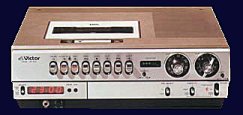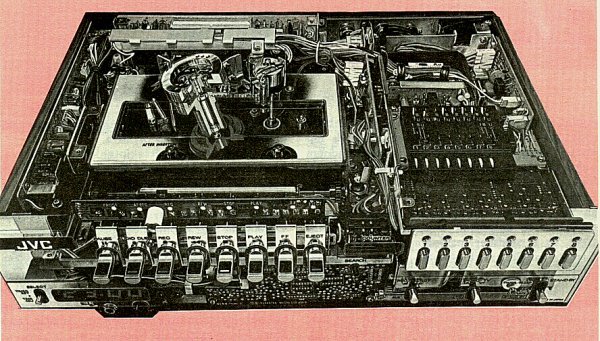 | |
 | |
 | |
 | |
 | ||||||
| ||||||
 |  | |||||
 | FORMAT: VHS | |||||
DATE: 1978 PRICE: £620 [2005: £2400] 46x32x16 cm 13.5 kg | ||||||
 |  |
|
| ||||||||||||||||||||||||||||||
| The very first VHS deck of all, launched in Japan in 1976 and the USA in 1977, had "cooker style" rotary knobs for tuning and timer -- much like the Philips 1500. By the time VHS reached the UK, these had been replaced by an electronic push-button tuner and a digital timer. The first to reach the UK, in 1978, was the HR-3300EK. The Ferguson pictured here is a "badge engineered" clone of the 3300. |  |
| It is a piano-key operated top-loader, with a red LED digital clock/timer giving a single recording event, limited to 24 hours ahead. Unlike the Betamax machines of the time, the end time is also set on the clock, rather than from a small number of pre-set timing options. | |
 | Since this is the "ancestor" of all modern VHS decks, there aren't many big surprises in the operating controls. Audio dub is included in the row of operating keys, but this was common for machines of this era -- the manufacturers hadn't yet realised that such features, while simple to add from a mechanical and electronic point of view, were beyond most normal users! |
| The keys are locked mechanically so you can't press (say) FF or REW while playing without pressing STOPfirst. There's no picture search, of course, and the pause key just halts the tape with a black screen. | |
| Perhaps the most obvious difference from modern machines is the row of three switches on the right, below the channel selector buttons. The rightmost one is the main function selector, used to select normal operating mode, timed recording or TV watching, and the leftmost one is used to select the tuner or auxiliary input for recording -- which is only unusual in that it's on the front of the machine. The switch in the middle is the oddest: it selects the output that the machine sends to the TV -- from the aerial or from the tape. |  |
| This means that you had to set all three of these switches correctly, depending on whether you were recording, playing, watching TV while recording or just watching TV with the machine off. Get one of the switches wrong, and you wouldn't see anything, or worse, wouldn't record anything. I've read the manual twice and I'm still not sure how to set these correctly for all operations; it's a good job that all later machines made these more automatic! |
 | Internally, the head drum is the most obvious feature, as usual. VHS head drums are smaller than Beta, 62mm as opposed to 75mm (and 105mm for the VCR series). Like the VCR and U-Matic machines the entire top half of the drum spins, carrying the heads with it; Betamax mounts the heads on a separate internal disc which protrudes through a slot in the otherwise stationary drum. |
The VHS lacing system is also entirely different, the tape being pulled out of the cassette by two loading "fingers" into an M shape with the drum in the middle:  This system is commonly known as M-lacing, to distinguish it from the Betamax/U-Matic system, which is called C-lacing. The loading fingers also carry guides to angle the tape around the drum, and are locked into their loaded position by clamps. The M-lacing system is simpler to work on since everything is laid out along the tape path; the Betamax approach tends to gather everything together in a tight cluster around the drum. Another key difference between the two systems is that VHS only laces up when a play or record operation is active. For all other operations the tape is returned to the cassette. The benifit of this is that the tape can be fast forwarded and rewound at higher speed, since the tape doesn't have to pass around the drum; the downside is that you have to wait several seconds after pressing Play while the machine laces, before a picture appears - or more importantly, before Record starts recording. |
| It was also thought that the Beta system would wear out the tape more quickly than VHS, since the tape is still wrapped around the drum during fast winding. However, the tape is under less tension in Betamax, and as it turned out tape wear was never an issue. Tapes recorded on this machine when it was new will probably still play perfectly well. |
VHS uses an optical system to detect the ends of the tape. A light on the end of a pole sticks up through a hole in the casette, between the two spools; the tape leader is transparent, which allows the light to shine through it and reach sensors at the si des of the machine. Hence the end of the tape, or the lack of any tape at all, is easily detected. All modern VHS machines use invisible infra-red light for this, but this machine has a simple white-light bulb. The Philips VCR series also used a (visible) light-based system, while Betamax machines use a metal foil leader with electronic sensors. Cutaway diagram of the 3300 Another interesting feature is that the circuits are all made up of "discrete" components -- transistors, capacitors, resistors etc. There are no I.C.s ("chips") to be seen; these didn't start to appear in VCRs until a year or so later. |